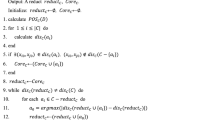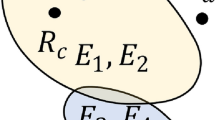Abstract
Attribute reduction with rough set is a popular data analysis methodology for data dimensionality reduction. For dynamic datasets, the existing research has mainly focused on incremental attribute reduction with increasing samples (rows) or attributes (columns), but there is hardly any further research on attribute reduction for dynamic datasets with simultaneously increasing samples and attributes. This paper presents a novel incremental algorithm for attribute reduction with rough set. Firstly, the definition of discernibility relation is proposed based on the improved discernibility matrix. Then, the incremental mechanisms of samples and attributes are studied in terms of discernibility relation under a unified framework. On the basis of two incremental mechanisms, a unified incremental mechanism is introduced for dynamic datasets with simultaneously increasing samples and attributes, and the incremental algorithm is developed according to the unified incremental mechanism. The proposed algorithm has the solid mathematical foundation, which is also suitable for datasets with massive samples and attributes. Finally, compared experimentally with other algorithms, the efficiency of the developed incremental algorithm is demonstrated in terms of running time.




Similar content being viewed by others
References
Bazan J (2000) Chapter 17 A comparison of dynamic and non-dynamic rough set methods for extracting laws from decision tables. Rough sets in knowledge discovery 1. Physica-Verlag HD
Bang W, Bien Z (2007) Incremental inductive learning algorithm in the framework of rough set theory and its application. Int J Fuzzy Syst 1:25–36
Chen DG, Yang YY (2014) Attribute reduction for heterogeneous data based on the combination of classical and fuzzy rough set models. IEEE Trans Fuzzy Syst 22(5):1325–1334
Chen DG (2013) Fuzzy rough set theory and method. Beijing, China
Chen DG, Zhao SY, Zhang L, Yang YY, Zhang X (2012) Sample pair selection for attribute reduction with rough set. IEEE Trans Knowl Data Eng 24(11):2080–2093
Chen DG, Zhang L, Zhao SY, Hu QH, Zhu P (2012) A novel algorithm for finding reducts with fuzzy rough sets. IEEE Trans Fuzzy Syst 20(2):385–389
Guan L (2009) An incremental updating algorithm of attribute reduction set in decision tables. In: International conference on fuzzy systems and knowledge discovery. Tianjin, China, vol 6, pp 421–425
Hao C, Li JH, Fan M, Liu WQ, Tsang Eric CC (2017) Optimal scale selection in dynamic multi-scale decision tables based on sequential three-wan decisions. Inf Sci 415:213–232
Hu F, Dai J, Wang G (2007) Incremental algorithms for attribute reduction in the decision table. Control Decis 22(3):268–277
Hu F, Wang G, Huang H, Wu Y (2005) Incremental attribute reduction based on elementary sets. In: Proceedings of 10th International Conference on Rough Sets. Fussy Sets. Data Mining and Granular Computing. Regina. pp 185–193
Hu QH, Yu DR, Xie ZX, Li XD (2007) EROS: ensemble rough subspaces. Pattern Recognit 40(12):3728–3739
Hu QH, Zhang L, Chen DG, Pedrycz W, Yu DR (2010) Gaussian kernel based fuzzy rough sets: model, uncertainty measures and applications. Int J Approx Reason 51(4):453–471
Hu QH, Yu DR, Pedrycz W, Chen DG (2011) Kernelized fuzzy rough sets and their applications. IEEE Trans Knowl Data Eng 23(11):1649–1667
Blaszczynski J, Slowinski R (2003) Incremental induction of decision rules from dominance-based rough approximations. Electron Notes Theor Comput Sci 84(4):40–51
Jing Y, Li T, Fujita H, Wang B, Cheng C (2018) An incremental attribute reduction method for dynamic data mining. Inf Sci 465:202–218
Jing Y, Li T, Huang J, Zhang Y (2016) An incremental attribute reduction approach based on knowledge granularity under the attribute generalization. Int J Approx Reason 76:80–95
Luo C, Li T, Chen H, Liu D (2012) An incremental approach for updating approximations based on set-valued ordered information systems. In: International conference on rough sets and current trends in computing, Springer, Berlin, pp 363–369
Li JH, Aswani Kumar C, Mei CL, Wang XZ (2017) Comparison of reduction in formal decision contexts. Int J Approx Reason 80:100–122
Li WT, Pedrycz W, Xue XP, Xu WH, Fan BJ (2019) Fuzziness and incremental information of disjoint regions in double-quantitative decision-theoretic rough set model. Int J Mach Learn Cybernet 10:2669–2690
Li T, Ruan D, Geert W, Song J, Xu Y (2007) A rough sets based characteristic relation approach for dynamic attribute generalization in data mining. Knowl-Based Syst 20(5):485–494
Liang J, Wang F, Dang C, Qian Y (2014) A group incremental approach to feature selection applying rough set technique. IEEE Trans Knowl Data Eng 26(2):294–308
Liu ZT (1999) An incremental arithmetic for the smallest reduction of attributes. Acta Electron Sinica 27(11):96–98
Miao D, Zhao Y, Yao Y, Li H, Xu F (2009) Relative reducts in consistent and inconsistent decision tables of the Pawlak rough set model. Inf Sci 179(24):4140–4150
Modrzejewski M (1993) Feature selection using rough sets theory. Machine learning: ECML-93. In: European conference on machine learning, Vienna, Austria, pp 213–226
Orlowska M, Orlowski M (1992) Maintenance of knowledge in dynamic information systems. Intelligent decision support. Springer, Netherlands, pp 315–329
Pawlak Z (1982) Rough sets. Int J Comput Inform Sci 11(5):341–356
Pawlak Z (1991) Rough sets: theoretical aspects of reasoning about data. Kluwer Academic Publishers, Berlin
Riza LS, Janusz A, Bergmeir C, Cornelis C, Herrera F, Slezak D, Benitez JM (2014) Implementing algorithms of rough set theory and fuzzy rough set theory in the R package ‘‘RoughSets’’. Inf Sci 287:68–89
Rahman M, Islam M (2014) FIMUS: a framework for imputing missing values using co-appearance, correlation and similarity analysis. Knowl Based Syst 56:311–327
Skowron A, Rauszer C (1992) The discernibility matrices and functions in information systems. Intell Decis Support 11:331–362
Susmaga R (1998) Experiments in incremental computation of reducts. Methodol Appl 18:530–553
Swiniarski RW, Skowron A (2003) Rough set methods in feature selection and recognition. Pattern Recogn Lett 24(6):833–849
Shan N, Ziarko W (2010) Data-based acquisition and incremental modification of classification rules. Comput Intell 11(2):357–370
Shu W, Shen H (2014) Updating attribute reduction in incomplete decision systems with the variation of attribute set. Int J Approx Reason 55(3):867–884
Stawicki S, Ślęzak D (2013) Recent advances in decision bireducts: complexity, heuristics and streams. Rough sets and knowledge technology. Springer, Berlin
Teng S, Liu M, Yang A, Zhang J, Nian Y, He M (2016) Efficient attribute reduction from the viewpoint of discernibility. Inf Sci 326:297–314
Wang CZ, Huang Y, Shao MW, Fan XD (2019) Fuzzy rough set-based attribute reduction using distance measures. Knowl-Based Syst 164:205–212
Wang CZ, Huang Y, Shao MW, Hu QH, Chen DG (2019) Feature selection based on neighborhood self-information. https://doi.org/10.1109/tcyb.2019.2923430xv
Wang CZ, Shi YP, Fan XD, Shao MW (2019) Attribute reduction based on k-nearest neighborhood rough sets. Int J Approx Reason 106:18–31
Wang CZ, Wang Y, Shao MW, Qian YH, Chen DG (2019) Fuzzy rough attribute reduction for categorical data. IEEE Trans Fuzzy Syst. https://doi.org/10.1109/tfuzz.2019.2949765
Wang F, Liang J, Qian Y (2013) Attribute reduction: a dimension incremental strategy. Knowl-Based Syst 39(2):95–108
Wang Q, Li JH, Wei L, Qian T (2020) Optimal granule level selection: a granule description accuracy viewpoint. Int J Approx Reason 116:85–105
Yang M (2007) An incremental updating algorithm for attributes reduction based on the improved discernibility matrix. Chin J Comput 30(3):815–822
Yao YY, Zhao Y (2008) Attribute reduction in decision-theoretic rough set models. Inf Sci 178(17):3356–3373
Yang Y, Chen D, Wang H (2017) Active sample selection based incremental algorithm for attribute reduction with rough sets. IEEE Trans Fuzzy Syst 25(4):825–838
Zhao SY, Tsang ECC, Chen DG (2010) The model of fuzzy variable precision rough sets. IEEE Trans Fuzzy Syst 17(2):451–471
Zhao SY, Chen H, Li CP, Zhai MY, Du XY (2013) RFRR:robust fuzzy rough reduction. IEEE Trans Fuzzy Syst 21(5):825–841
Zhao SY, Tsang ECC, Chen DG, Wang XZ (2010) Building a rule-based classifier-a fuzzy-rough set approach. IEEE Trans Knowl Data Eng 22(5):624–638
Zhao SY, Chen H, Li CP, Du XY, Sun H (2015) A novel approach to building a robust fuzzy rough classifier. IEEE Trans Fuzzy Syst 23(4):769–786
Acknowledgements
This work is supported by the fund ofNorth China Electric Power University and the Fundamental Research Funds for the Central Universities (2018QN050).
Author information
Authors and Affiliations
Corresponding author
Additional information
Publisher's Note
Springer Nature remains neutral with regard to jurisdictional claims in published maps and institutional affiliations.
Rights and permissions
About this article
Cite this article
Dong, L., Chen, D. Incremental attribute reduction with rough set for dynamic datasets with simultaneously increasing samples and attributes. Int. J. Mach. Learn. & Cyber. 11, 1339–1355 (2020). https://doi.org/10.1007/s13042-020-01065-y
Received:
Accepted:
Published:
Issue Date:
DOI: https://doi.org/10.1007/s13042-020-01065-y




